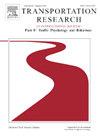Intention to adopt electric motorcycles in developing markets: Examining the role of image, motivators and barriers through the behavioral reasoning theory framework
IF 3.5
2区 工程技术
Q1 PSYCHOLOGY, APPLIED
Transportation Research Part F-Traffic Psychology and Behaviour
Pub Date : 2025-02-01
DOI:10.1016/j.trf.2025.01.005
引用次数: 0
Abstract
Carbon emissions from fuel-based motorcycles are compromising the sustainability of transport systems in low- and middle-income countries. To address this issue, the decarbonization of the transportation sector through the adoption of electric motorcycles (EMs) has attracted growing attention from both practitioners and academics. However, existing research on EM adoption intentions has predominantly focused on the factors facilitating adoption, with limited inquiries into both the reasons for and against EM adoption. This study applies Behavioral Reasoning Theory (BRT) to examine the role of EM image in shaping consumers’ attitudes and intentions toward EM adoption. It also investigates how consumers’ reasons for and against adopting EMs mediate the relationships between EM image and these attitudes and intentions. Data were collected from 762 residents without EM ownership across two major cities in Vietnam. Partial least squares structural equation modeling was employed to analyze the relationships between variables. The findings revealed that EM image positively influences reasons for, reasons against, and attitudes toward EM adoption. Reasons for EM adoption are positively associated with both attitudes and intentions to adopt EMs, whereas reasons against EM adoption negatively impact intentions and show a non-significant effect on attitudes. Additionally, the study confirmed the positive relationship between attitudes and intentions to adopt EMs. These results advance the existing literature on EM adoption by highlighting the predictive roles of EM image and behavioral reasoning in shaping consumers’ attitudes and intentions toward adopting EMs.
求助全文
约1分钟内获得全文
求助全文
来源期刊
CiteScore
7.60
自引率
14.60%
发文量
239
审稿时长
71 days
期刊介绍:
Transportation Research Part F: Traffic Psychology and Behaviour focuses on the behavioural and psychological aspects of traffic and transport. The aim of the journal is to enhance theory development, improve the quality of empirical studies and to stimulate the application of research findings in practice. TRF provides a focus and a means of communication for the considerable amount of research activities that are now being carried out in this field. The journal provides a forum for transportation researchers, psychologists, ergonomists, engineers and policy-makers with an interest in traffic and transport psychology.

 求助内容:
求助内容: 应助结果提醒方式:
应助结果提醒方式:


